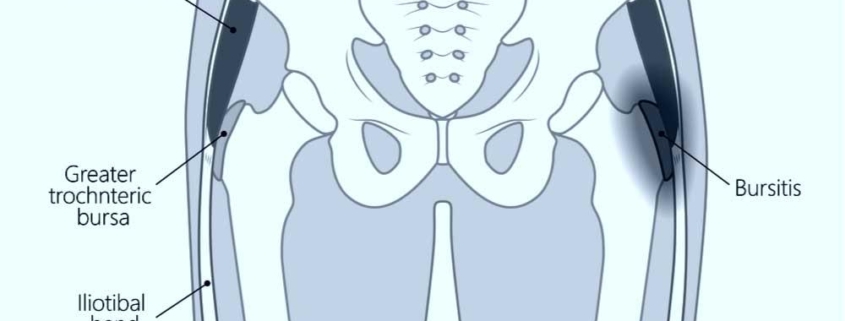
Hip Bursitis
Overview
Hip bursitis, also known as trochanteric bursitis, is a common source of hip pain. It occurs when a small, fluid-filled sac in the hip called the bursa becomes inflamed. This sac acts as a cushion for your bones and tendons, but when it’s irritated, it can cause a lot of discomfort. Hip bursitis is typically characterized by pain on the outer side of the hip, though the pain can also spread to other parts of the body like the thigh or buttock. Although the condition can affect anyone, it’s more prevalent in middle-aged or elderly individuals.
Types
There are mainly two types of hip bursitis:
– Trochanteric Bursitis: This is the most common type of hip bursitis and affects the bursa covering the bony point of the hip bone.
– Iliopsoas Bursitis: Less common, this type affects the bursa located on the inside (groin side) of the hip.
Each type has slightly different symptoms and can be caused by different factors, but both types are treatable.
Causes
Hip bursitis can be caused by several factors, including:
– Repetitive use or overuse of the hip joint.
– A direct injury to the hip, such as a fall or bump.
– Hip surgery or spinal surgery.
– Diseases such as rheumatoid arthritis, hip osteoarthritis, or lupus.
– Differences in leg length can lead to hip bursitis, as it causes extra stress on the bursae.
– Incorrect posture over a prolonged period.
Symptoms
Common symptoms of hip bursitis include:
– Pain at the outer side of the hip.
– Pain when lying on the affected hip.
– Pain that worsens with walking, climbing stairs, or getting out of a chair.
– Pain that gets worse at night.
– Tenderness in the hip area.
In rare cases, the pain may radiate down the outside of the thigh towards the knee.
Diagnosis
A healthcare provider will typically diagnose hip bursitis based on your history and a physical examination. They may look for tenderness over the hip, assess your range of motion, and conduct specific tests to rule out other conditions. An X-ray, ultrasound, or MRI may be ordered to confirm the diagnosis and rule out other potential causes of your symptoms, such as a fracture or arthritis.
Treatment Options
Treatment for hip bursitis typically includes:
– Rest and avoiding activities that worsen your symptoms.
– Non-prescription pain medications like acetaminophen or NSAIDs.
– Physical therapy exercises to improve flexibility and strength.
– Application of ice to the affected area.
If conservative treatments fail, your healthcare provider may recommend:
– Corticosteroid injections to decrease inflammation and pain.
– Surgery, in rare cases, to remove the bursa.
Living With Hip Bursitis
Living with hip bursitis involves managing your symptoms and preventing future flare-ups. This may include:
– Regularly conducting physical therapy exercises.
– Taking over-the-counter pain relievers as needed.
– Applying ice packs to the hip for 15 minutes at a time to reduce inflammation.
– Wearing supportive shoes and avoiding high heels.
– Avoiding prolonged sitting or standing and taking regular breaks to move around.
When to Seek Help
You should seek immediate medical attention if the pain becomes so severe that you can’t stand or walk, the pain happens suddenly, the hip area looks deformed or swollen, or the pain hasn’t improved within one to two weeks of conservative treatment. Effective management of hip bursitis often involves early diagnosis and adherence to a comprehensive treatment plan.
